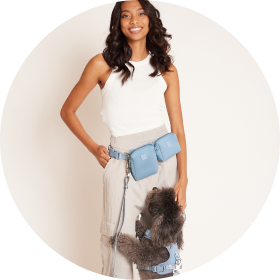- Home
- The Daily Wag!
- Senses
- Can Dogs Have Gout?

It's likely that you've heard of gout - it's a painful, unfortunate form of arthritis that can develop when high levels of uric acid are present in the bloodstream. You know that humans can get gout, but did you know that your dog can, too?
Unfortunately, your poor pup can suffer from gout, but it won't look the same as it does for humans. When your doggo gets gout, it usually manifests itself in bladder disease because of the high buildup of uric acid. While gout in arthritic form is possible with pups, it's pretty rare, so look out for bladder issues instead.
So, how can you tell if your dog has gout? What signs should you watch out for? Is there anything you can do to help your dog avoid uric acid buildup, bladder issues, and gout in general? Read the rest of our doggo-gout guide to get a better idea of how you can help your pooch combat this condition.
As we said, if your pup contracts gout, it will likely manifest itself in different ways than you're used to. With people, arthritic issues typically pop up as a result of gout, but with dogs, it's likely going to show up with bladder issues.
For example, if your dog is having a really hard time going to the restroom, seems to be in pain when he or she is trying to urinate, or can only urinate very small amounts at a time (or no urine at all), you might be dealing with a gout issue.
If you're suspecting gout already, take a look at your dog's urine. Does it look brown? Red? Discolored in any way? Do you think your dog's urine is bloody? Any of these signs could point to your dog contracting gout.
Body Language
Here are a few body language signs your dog might be giving you to let you know he or she is having gout like symptoms:
- Weakness
- Lack Of Focus
- Dropped Ears
- Tail Tucking
Other Signs
There are other signs to watch out for, too, like:
- Incontinence
- Lethargy Or Laziness
- Bloody Urine
- Unable To Produce Urine
- Joint Issues (Rare Cases)
The ultimate cause of gout is a heavy build-up of uric acid that is deposited in the body tissue. These needle-like crystals will typically build up in the joints of people, but when it comes to dogs, it will typically manifest itself in their urine, causing a lot of bladder issues.
What are the causes of gout for pups, you might wonder? There are a lot of different issues. A diet that's way too high in protein could be one of the causes. Genetic factors are always something to consider, too. Your dog also might not have a healthy or functioning liver or kidney that is supposed to clear uric acid from their system.
Kidney disease is one of the leading causes of gout because it causes an impaired ability to get rid of the waste products properly. Historically, Dalmations have one of the highest rates of gout for pups because their metabolic systems are unique and will not allow excess levels of protein to pass through the blood.
Gout, as we said, is a build-up of needle-like uric acids that affect your dog's bladder health. Though typically gout won't affect your pup's joints or manifest itself as arthritis, canine gout can appear in a pup's paws, toes, joints, and neck area.
Often, when this happens, your dog will develop calcium-deposit lesions that can be both painful and fatal if not treated properly. Luckily, if gout is caught and treated early on, then the disease can be incredibly manageable. Other ways your dog will likely be affected by gout is through bloody urine, incontinence, and even lumps on your dog's body.
If your dog contracts gout from a buildup of uric acid in his or her blood or urine, you can bet your poor pooch is going to be uncomfortable. Training your dog to deal with this issue while they heal may take a little trial and error, but hopefully, in the long run, it will help your dog deal with their symptoms a bit better.
For starters, it's important that your dog has a firm grasp on letting you know when he or she has to use the bathroom. If your dog is a little iffy on this point, it's possible that their frequent trips to the bathroom will end up somewhere on your carpet. Ensure that your dog knows how to let you know when it's time to go outside, even if its 20-30 times a day.
It's also important when your pup has gout that they take it easy to allow time to heal. Make sure you're keeping your pup low-key and not hyperactive while they heal up.
Additionally, it's likely your pooch will have to take some pills that the dog-tor prescribes in order to heal up. Make sure you've trained your dog to take pills. There are few different options with this. Either train your dog to eat his or her pills with their food, take the pill from your hand, or play a fun throw-and-catch game with their pills to ensure that they're getting the medicine they need.
Alternatively, switching up your pups diet might help with gout too. If you choose to do this, ensure that you do so slowly and progressively so as not to mess up your pooch's digestion too badly.
Have questions or concerns about your pet?
Chat with a veterinary professional in the Wag! app 24/7.
Get Vet ChatWritten by a Great Dane lover Hanna Marcus
Veterinary reviewed by:
Published: 04/06/2018, edited: 04/06/2020
More articles by Hanna Marcus
